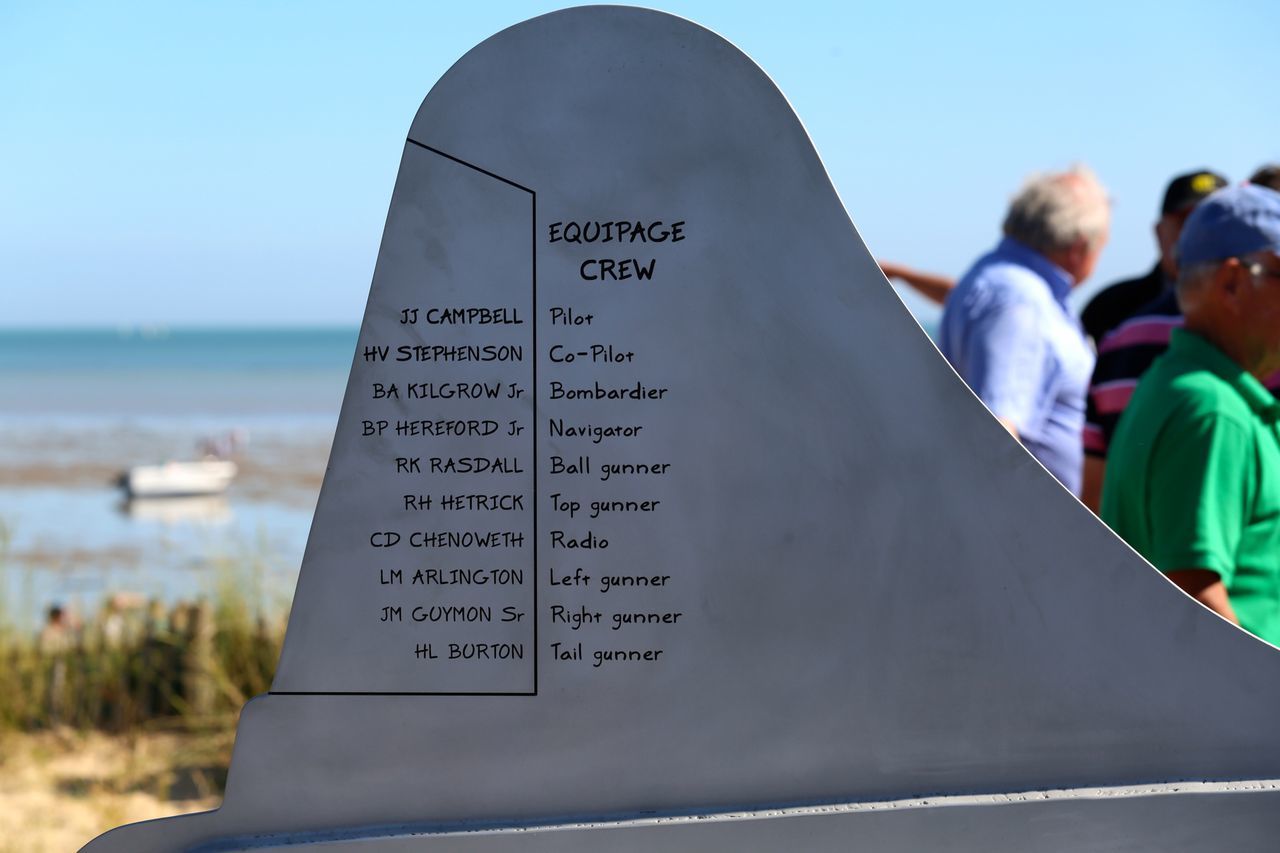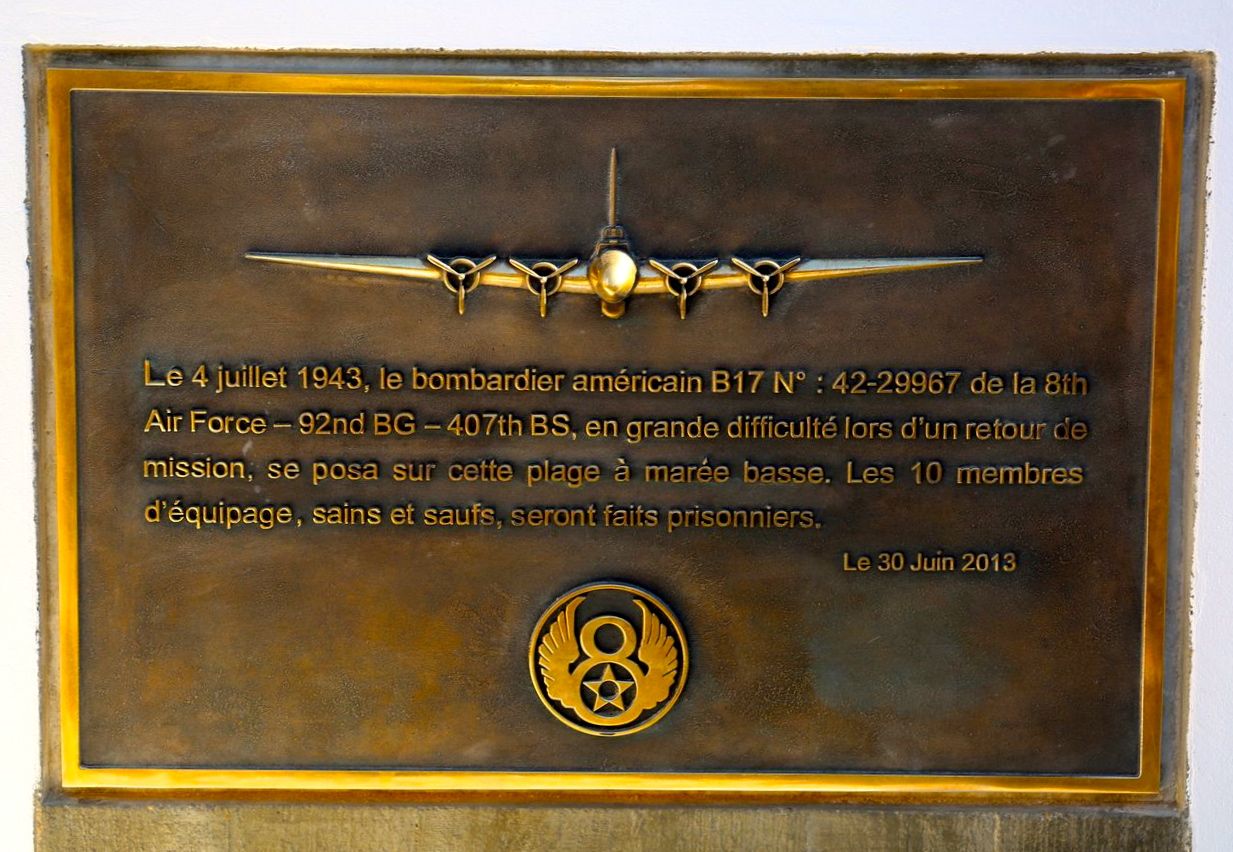As many as 10,000 Frenchmen — and a few Americans — gathered Sunday to honor an American bomber crew downed 70 years ago on July 4, 1943 off of a small island in northern France. A young French girl, Anne, saw the American fly boys captured by the Nazis after their plane went down in the shallow water, where it sometime appears to this day as the tides change. For her, the plane was proof of America’s commitment to France and to its coming liberation.
Robbin Laird, a member of the Breaking Defense Board of Contributors, attended the ceremony and saw the only operational B-17 in Europe fly by in commemoration. His video of the sole B-17 flying in Europe should give you goosebumps. Here’s his account of the day and what he thinks its signifies. The Editor.
NOIRMOUTIER ISLAND, FRANCE: Inside the Beltway, one can often lose one’s sense of reality. One of these realities is how much perception matters in the big world out there. For example, showing up to honor allied memories and to be present in major events is crucial to shaping current and future capabilities.
As American Lt. Gen. (ret.) Dave Deptula, recently reminded us, the dance called sequestration between the Obama administration and Congress has real consequences: we are enforcing a no-fly zone on the United States and not against adversaries.
It’s not only in the US that sequestration is affecting how allies, observers and potential enemies see us. The absence of the US Air Force from last month’s Paris Air Show at Le Bourget was certainly noted. And it was only by a miracle that the Air Force was represented at a powerful ceremony held on Noirmoutier Island, France, the scene of a World War II B-17 raid, and the rescue of downed crewmen after a raid against Nazi air and maritime facilities in this part of France.
For the crew that would fly on July 4, 1943, their training saved their lives. As one of the participants in the ceremony, the brother of the co-pilot of the plane crewed by the “Battling Bastards,” commented that if his brother were at the ceremony he would have highlighted the skill and courage of the pilot who landed the Flying Fortress in the water at low tide with only one working engine.
Training matters. For the B-17 crews flying in Europe, every flight into Nazi held territory was their Pointe du Hoc moment: Fighting uphill against tough odds, with the distinct possibility of not coming back without the proper training even fewer crew members would have survived.
As one B-17 crewmember wrote in his diary about a bombing run against Le Bourget on August 16, 1943,
Soon after daylight the formation was crossing the gray-green water of the English Channel. My anxiety and tension mounted, as I knew we would invade the lair of Goering’s best. The veterans had made certain we know what usually happened to new crews on their first meeting with Jerry. They were not expected to come back – it was as simple as that.”
The crew, which flew on July 4, 1943, was part of what history would remember as the Mighty 8th, but it certainly was not yet the Mighty 8th. It was a group of airmen just starting to forge an identity. The crew was from the 92nd Bomber Group, and members of the 407th Bomber Squadron.
Among the targets from May 1943 through February 1944 attacked by this bomber group were: shipyards at Kiel; ball-bearing plants at Schewinfurt; submarine installations at Wilhelmshaven; a tire plant at Hanover; airfields near Paris; an aircraft factory at Nantes; and a magnesium mine and reducing plant in Norway. A pretty wide-ranging and impressive set of targets!
The 10-crew members of the July 4, 1943 raid crash landed on Noirmoutier Island, France and became prisoners of the Third Reich.
They crashed during the turning point of the war. But given that only God knows the outcome, warriors in 1943 could sense the turning but not yet feel the victory. America was engaged in a two front war, with the clear public priority to avenge for the surprise attack on Pearl Harbor. President Roosevelt wished to prioritize the effort in Europe but only the Miracle of the Battle of Midway (June 1942) would allow him to have the political space to do so.
The year 1943 began with the Soviet victory at Stalingrad. The capture of the 6th Army at Stalingrad was the first great defeat for the Nazis. This was to be followed by the surrender of the Afrika Corps in May 1943.
The largest tank battle in history was being fought and won by the Russians against the Germans in early July 1943. The allied invasion of Sicily was to begin on July 10th and Mussolini was to be overthrown by the Italians on July 25, 1943.
As the American crew entered their B-17 on July 4, 1943, they could not know how significant that month would prove to be for the war effort.
And for the Mighty 8th, they were to participate with the British in the largest firestorm bombing in history (up to that point of time) a joint US-British massive bombing assault on Hamburg. It began on July 24th and the fires burned in Hamburg until October.
The raid on July 4, 1943 marked the first anniversary of Eighth Air Force bomber operations from the UK. The occasion was marked by a three-pronged assault in force with the 192 1st Wing Fortresses attacking aircraft works at Le Mans and Nantes while 83 planes struck La Pallice.
Here’s the report on the bombing activities of the 8th Air Force for activities on July 4, 1943 from the official logs:
8th Bomber Command Mission 71: 192 B-17s are dispatched against aircraft factories at Le Mans and Nanes, France; 166 make a very effective attack; 83 other B-17s are dispatched against submarine yards at La Pallice, France; 71 hit the target between 1201 and 1204 local; U loses 1 and 1 is damaged; causalities are 10 MIA. Bombing is extremely accurate.
So what did it feel like to be a member of a B-17 crew in the summer of 1943?
One source of getting an insider’s feeling at the time was provided by the following comment from the crewmember diary mentioned above:
The Major hesitated before answering and studied a large chart on the wall crowded with names. See that chart? That’s the combat roster. We’ve been here 60 days, and so far we’ve lost a hundred and one percent of our combat personnel.
The French ceremony itself culminated in two events: the unveiling of a new monument to the crew of the B-17. It overlooks the beach where the plane can still be found.
The most compelling part of the ceremony in many ways was the presence of several generations of French who had organized the 70th anniversary. Seeing the US and French flags flying everywhere and many World War II vehicles, weapons and uniforms was part of the bonding experience as well.
The representative of the French Chief of Staff of the French Air Force, General (retired) Pierre Niclot emphasized the close relationship between the US and French Air Forces which culminated in the recent Mali operation, the “first in which the USAF went under the command of the French forces to support the operation.”
The US Air Force representative, Col. Peter Goldfein, emphasized solidarity among allies and highlighted the importance of the American and Fnrech air forces training and fighting together.
The impact on the older generation – still alive – who saw the plane crash land was quite impressive as well. The brother of the co-pilot, George Stephenson, told this story.
I want you to think back to 70 years ago. Vision a little girl (Anne Gloire) 12 years old dressed in a beautiful white dress, skipping along the path to her mother’s house near the beach. The little girl has just received her first communion….
Suddenly, Anne hears shooting from all around here – from the soldiers – from the sky – planes flying above her shooting. Then a very large plane appears with four engines with only one working. She was afraid it might hit her home. It crashes in the water not far from shore. She is terrified and cries for her mother to protect her.
Then she sees 10 men leave the plane with yellow vests. The soldiers are shooting at them. The men come to shore – several wounded by the soldiers. The soldiers shoved the men and loaded them into trucks and hauled them away. Anne wonders what would happen to them.
Stephenson told the thousands of French citizens gathered that on a trip to France some years ago, he meet Anne. He called his brother, the co-pilot, on a cell phone and they spoke. “This was closure for her.”
Better than any politician, Stephenson summed up the importance of the event: “I think today my brother today would say that the periodic appearance of his plane above the water gave hope to people in the village that liberation and freedom are coming soon and remains a symbol of freedom to this day.”
It won’t be if we do not show up. Sequestration — the damaging automatic budget cuts mandated by law — ultimately is about not showing up. And speaking of showing up, the sole remaining B-17 flying in Europe was flown by a private group, which is in desperate need of money to keep the plane flying. These folks are all British. It is time for Americans to step in and help. As citizens, we cannot use the excuse of sequestration.
To help them keep the B-17 flying in Europe, click here.
To read a special report on the lessons learned from the B-17 experience, click here.
The video was shot by Chloe Laird. The photos are courtesy of Second Line of Defense, a website owned by Robbin Laird.
Navy jet trainer fleet operations remain paused after engine mishap
One week after the incident, a Navy spokesperson says the service is continuing to assess the fleet’s ability to safely resume flight.





























